Critical Analysis of Norway's Climate Change Mitigation and Adaptation
VerifiedAdded on 2023/04/25
|18
|3957
|360
Essay
AI Summary
This essay provides a critical assessment of Norway's climate change policy and practice, focusing on mitigation and adaptation strategies. It begins by highlighting the global challenge of climate change and its impact on Norway, particularly the Arctic region. The essay then delves into specific policies and measures adopted by Norway, including international climate agreements like the Paris Agreement, carbon taxation, electrification of transport, emission-free land transport systems, reduction of PFC emissions in the aluminum industry, use of biogas, reduction of HFC emissions, emission trading schemes, and pollution control acts. Furthermore, the essay examines Norway's commitment to climate awareness campaigns and cooperation with the UN on carbon neutrality. The analysis also explains the factors influencing Norway's approach to climate change, considering the roles of various stakeholders in promoting or hindering climate action. This document is available on Desklib, a platform offering study tools and resources for students.
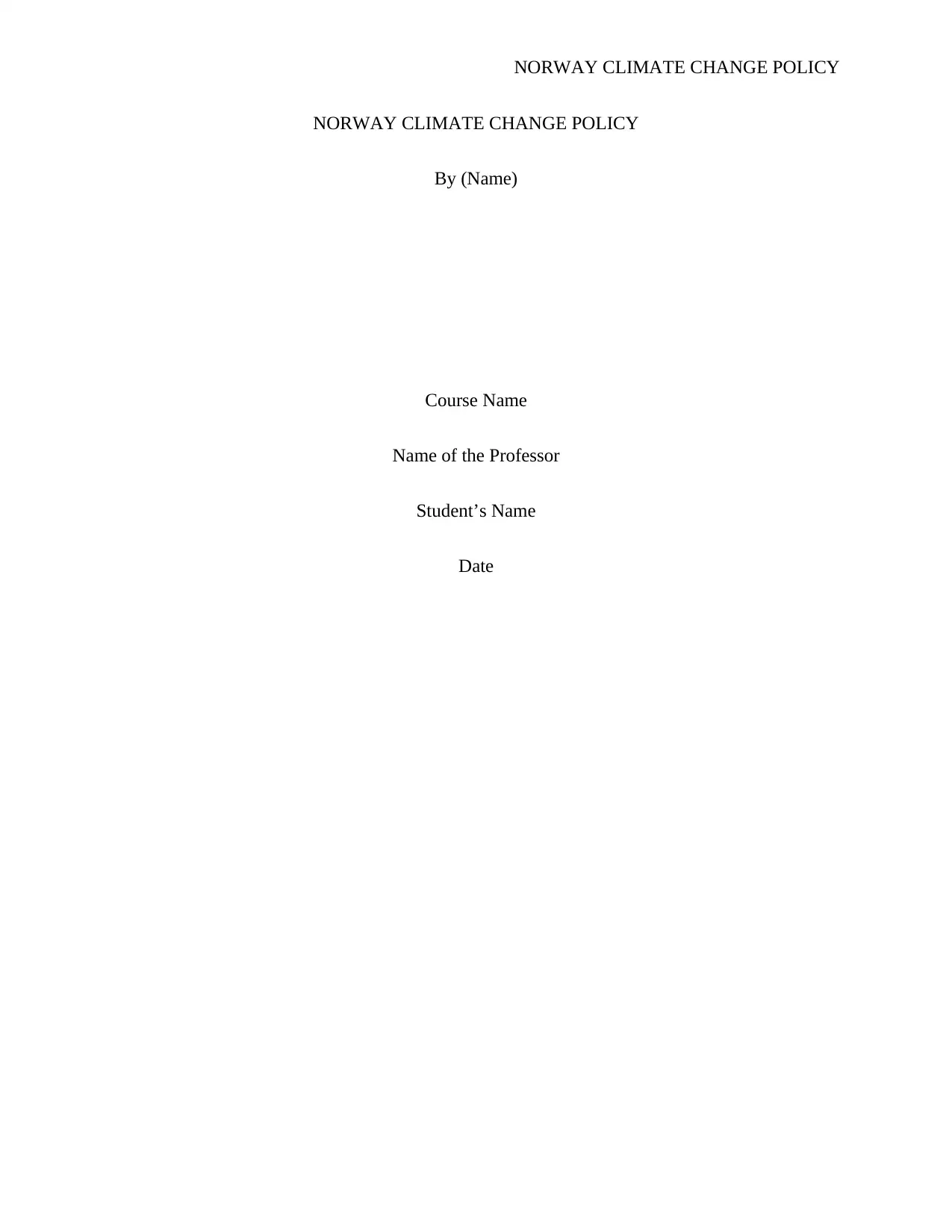
NORWAY CLIMATE CHANGE POLICY
NORWAY CLIMATE CHANGE POLICY
By (Name)
Course Name
Name of the Professor
Student’s Name
Date
NORWAY CLIMATE CHANGE POLICY
By (Name)
Course Name
Name of the Professor
Student’s Name
Date
Paraphrase This Document
Need a fresh take? Get an instant paraphrase of this document with our AI Paraphraser
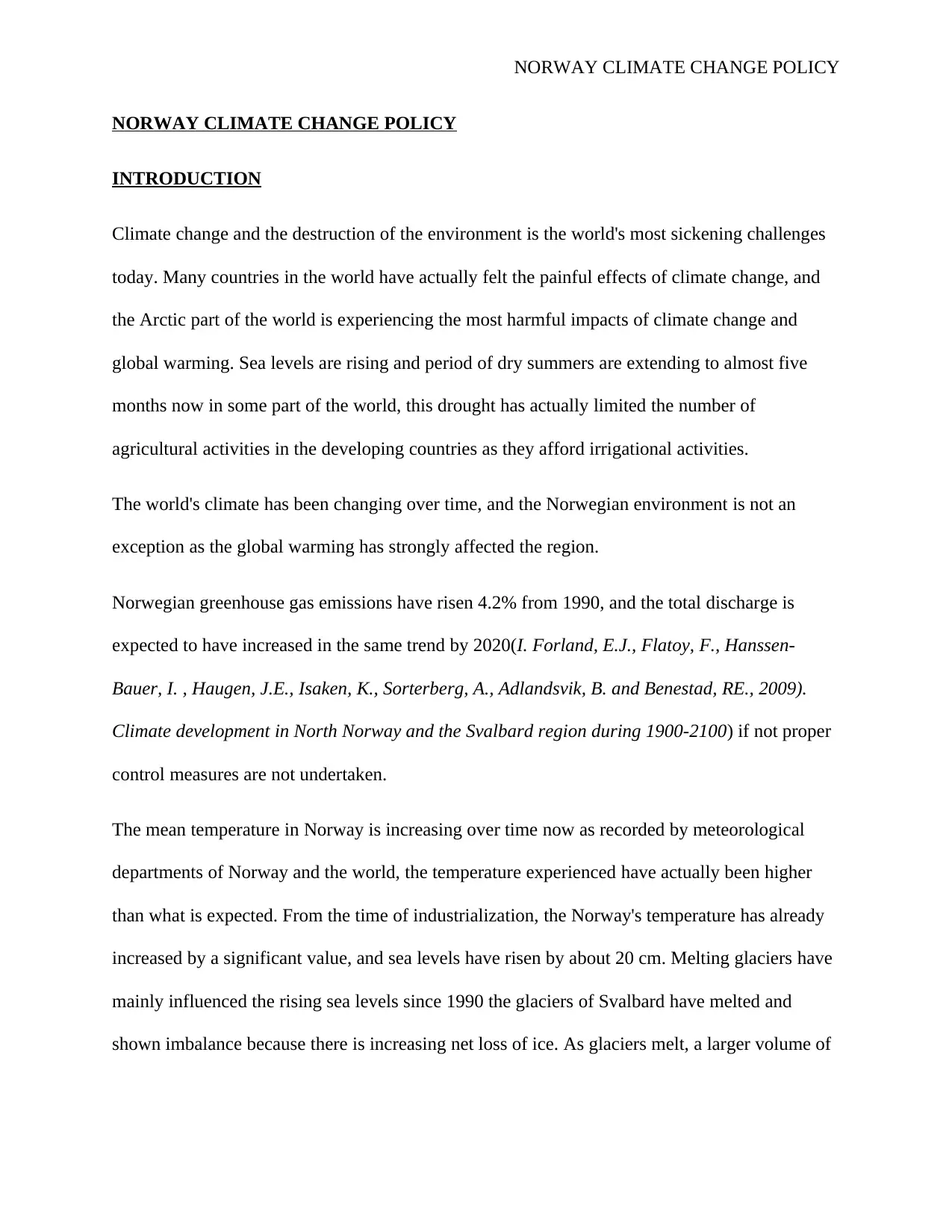
NORWAY CLIMATE CHANGE POLICY
NORWAY CLIMATE CHANGE POLICY
INTRODUCTION
Climate change and the destruction of the environment is the world's most sickening challenges
today. Many countries in the world have actually felt the painful effects of climate change, and
the Arctic part of the world is experiencing the most harmful impacts of climate change and
global warming. Sea levels are rising and period of dry summers are extending to almost five
months now in some part of the world, this drought has actually limited the number of
agricultural activities in the developing countries as they afford irrigational activities.
The world's climate has been changing over time, and the Norwegian environment is not an
exception as the global warming has strongly affected the region.
Norwegian greenhouse gas emissions have risen 4.2% from 1990, and the total discharge is
expected to have increased in the same trend by 2020(I. Forland, E.J., Flatoy, F., Hanssen-
Bauer, I. , Haugen, J.E., Isaken, K., Sorterberg, A., Adlandsvik, B. and Benestad, RE., 2009).
Climate development in North Norway and the Svalbard region during 1900-2100) if not proper
control measures are not undertaken.
The mean temperature in Norway is increasing over time now as recorded by meteorological
departments of Norway and the world, the temperature experienced have actually been higher
than what is expected. From the time of industrialization, the Norway's temperature has already
increased by a significant value, and sea levels have risen by about 20 cm. Melting glaciers have
mainly influenced the rising sea levels since 1990 the glaciers of Svalbard have melted and
shown imbalance because there is increasing net loss of ice. As glaciers melt, a larger volume of
NORWAY CLIMATE CHANGE POLICY
INTRODUCTION
Climate change and the destruction of the environment is the world's most sickening challenges
today. Many countries in the world have actually felt the painful effects of climate change, and
the Arctic part of the world is experiencing the most harmful impacts of climate change and
global warming. Sea levels are rising and period of dry summers are extending to almost five
months now in some part of the world, this drought has actually limited the number of
agricultural activities in the developing countries as they afford irrigational activities.
The world's climate has been changing over time, and the Norwegian environment is not an
exception as the global warming has strongly affected the region.
Norwegian greenhouse gas emissions have risen 4.2% from 1990, and the total discharge is
expected to have increased in the same trend by 2020(I. Forland, E.J., Flatoy, F., Hanssen-
Bauer, I. , Haugen, J.E., Isaken, K., Sorterberg, A., Adlandsvik, B. and Benestad, RE., 2009).
Climate development in North Norway and the Svalbard region during 1900-2100) if not proper
control measures are not undertaken.
The mean temperature in Norway is increasing over time now as recorded by meteorological
departments of Norway and the world, the temperature experienced have actually been higher
than what is expected. From the time of industrialization, the Norway's temperature has already
increased by a significant value, and sea levels have risen by about 20 cm. Melting glaciers have
mainly influenced the rising sea levels since 1990 the glaciers of Svalbard have melted and
shown imbalance because there is increasing net loss of ice. As glaciers melt, a larger volume of
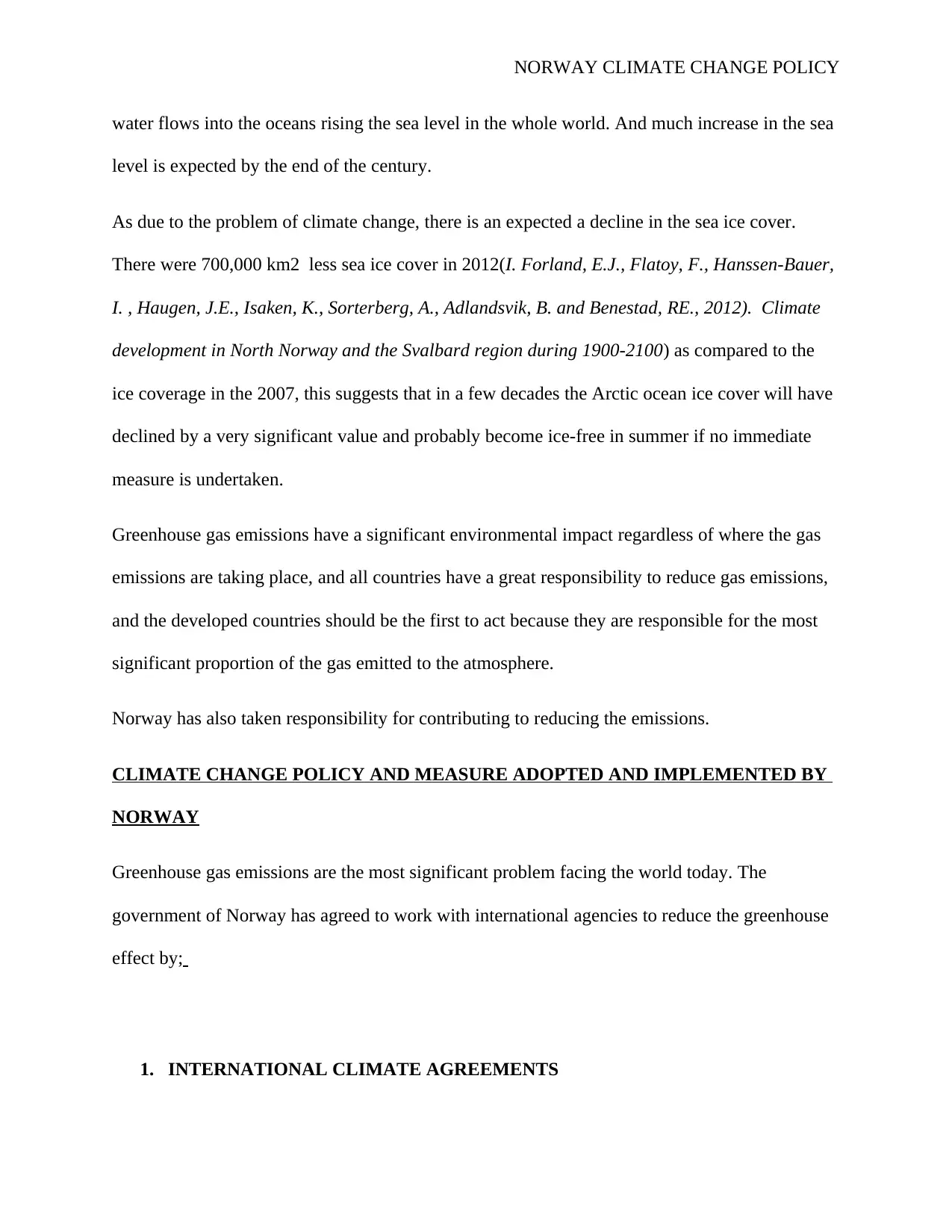
NORWAY CLIMATE CHANGE POLICY
water flows into the oceans rising the sea level in the whole world. And much increase in the sea
level is expected by the end of the century.
As due to the problem of climate change, there is an expected a decline in the sea ice cover.
There were 700,000 km2 less sea ice cover in 2012(I. Forland, E.J., Flatoy, F., Hanssen-Bauer,
I. , Haugen, J.E., Isaken, K., Sorterberg, A., Adlandsvik, B. and Benestad, RE., 2012). Climate
development in North Norway and the Svalbard region during 1900-2100) as compared to the
ice coverage in the 2007, this suggests that in a few decades the Arctic ocean ice cover will have
declined by a very significant value and probably become ice-free in summer if no immediate
measure is undertaken.
Greenhouse gas emissions have a significant environmental impact regardless of where the gas
emissions are taking place, and all countries have a great responsibility to reduce gas emissions,
and the developed countries should be the first to act because they are responsible for the most
significant proportion of the gas emitted to the atmosphere.
Norway has also taken responsibility for contributing to reducing the emissions.
CLIMATE CHANGE POLICY AND MEASURE ADOPTED AND IMPLEMENTED BY
NORWAY
Greenhouse gas emissions are the most significant problem facing the world today. The
government of Norway has agreed to work with international agencies to reduce the greenhouse
effect by;
1. INTERNATIONAL CLIMATE AGREEMENTS
water flows into the oceans rising the sea level in the whole world. And much increase in the sea
level is expected by the end of the century.
As due to the problem of climate change, there is an expected a decline in the sea ice cover.
There were 700,000 km2 less sea ice cover in 2012(I. Forland, E.J., Flatoy, F., Hanssen-Bauer,
I. , Haugen, J.E., Isaken, K., Sorterberg, A., Adlandsvik, B. and Benestad, RE., 2012). Climate
development in North Norway and the Svalbard region during 1900-2100) as compared to the
ice coverage in the 2007, this suggests that in a few decades the Arctic ocean ice cover will have
declined by a very significant value and probably become ice-free in summer if no immediate
measure is undertaken.
Greenhouse gas emissions have a significant environmental impact regardless of where the gas
emissions are taking place, and all countries have a great responsibility to reduce gas emissions,
and the developed countries should be the first to act because they are responsible for the most
significant proportion of the gas emitted to the atmosphere.
Norway has also taken responsibility for contributing to reducing the emissions.
CLIMATE CHANGE POLICY AND MEASURE ADOPTED AND IMPLEMENTED BY
NORWAY
Greenhouse gas emissions are the most significant problem facing the world today. The
government of Norway has agreed to work with international agencies to reduce the greenhouse
effect by;
1. INTERNATIONAL CLIMATE AGREEMENTS
⊘ This is a preview!⊘
Do you want full access?
Subscribe today to unlock all pages.

Trusted by 1+ million students worldwide
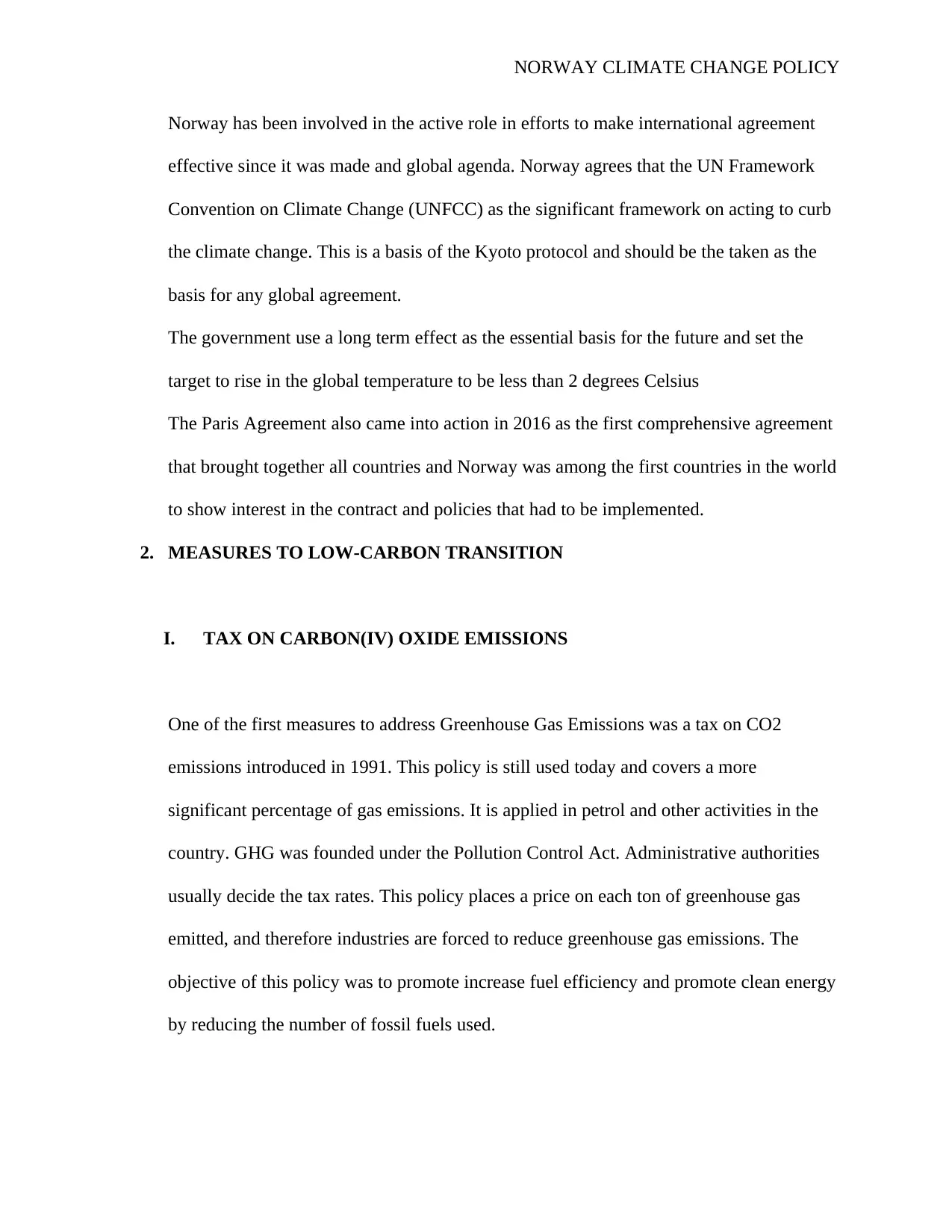
NORWAY CLIMATE CHANGE POLICY
Norway has been involved in the active role in efforts to make international agreement
effective since it was made and global agenda. Norway agrees that the UN Framework
Convention on Climate Change (UNFCC) as the significant framework on acting to curb
the climate change. This is a basis of the Kyoto protocol and should be the taken as the
basis for any global agreement.
The government use a long term effect as the essential basis for the future and set the
target to rise in the global temperature to be less than 2 degrees Celsius
The Paris Agreement also came into action in 2016 as the first comprehensive agreement
that brought together all countries and Norway was among the first countries in the world
to show interest in the contract and policies that had to be implemented.
2. MEASURES TO LOW-CARBON TRANSITION
I. TAX ON CARBON(IV) OXIDE EMISSIONS
One of the first measures to address Greenhouse Gas Emissions was a tax on CO2
emissions introduced in 1991. This policy is still used today and covers a more
significant percentage of gas emissions. It is applied in petrol and other activities in the
country. GHG was founded under the Pollution Control Act. Administrative authorities
usually decide the tax rates. This policy places a price on each ton of greenhouse gas
emitted, and therefore industries are forced to reduce greenhouse gas emissions. The
objective of this policy was to promote increase fuel efficiency and promote clean energy
by reducing the number of fossil fuels used.
Norway has been involved in the active role in efforts to make international agreement
effective since it was made and global agenda. Norway agrees that the UN Framework
Convention on Climate Change (UNFCC) as the significant framework on acting to curb
the climate change. This is a basis of the Kyoto protocol and should be the taken as the
basis for any global agreement.
The government use a long term effect as the essential basis for the future and set the
target to rise in the global temperature to be less than 2 degrees Celsius
The Paris Agreement also came into action in 2016 as the first comprehensive agreement
that brought together all countries and Norway was among the first countries in the world
to show interest in the contract and policies that had to be implemented.
2. MEASURES TO LOW-CARBON TRANSITION
I. TAX ON CARBON(IV) OXIDE EMISSIONS
One of the first measures to address Greenhouse Gas Emissions was a tax on CO2
emissions introduced in 1991. This policy is still used today and covers a more
significant percentage of gas emissions. It is applied in petrol and other activities in the
country. GHG was founded under the Pollution Control Act. Administrative authorities
usually decide the tax rates. This policy places a price on each ton of greenhouse gas
emitted, and therefore industries are forced to reduce greenhouse gas emissions. The
objective of this policy was to promote increase fuel efficiency and promote clean energy
by reducing the number of fossil fuels used.
Paraphrase This Document
Need a fresh take? Get an instant paraphrase of this document with our AI Paraphraser
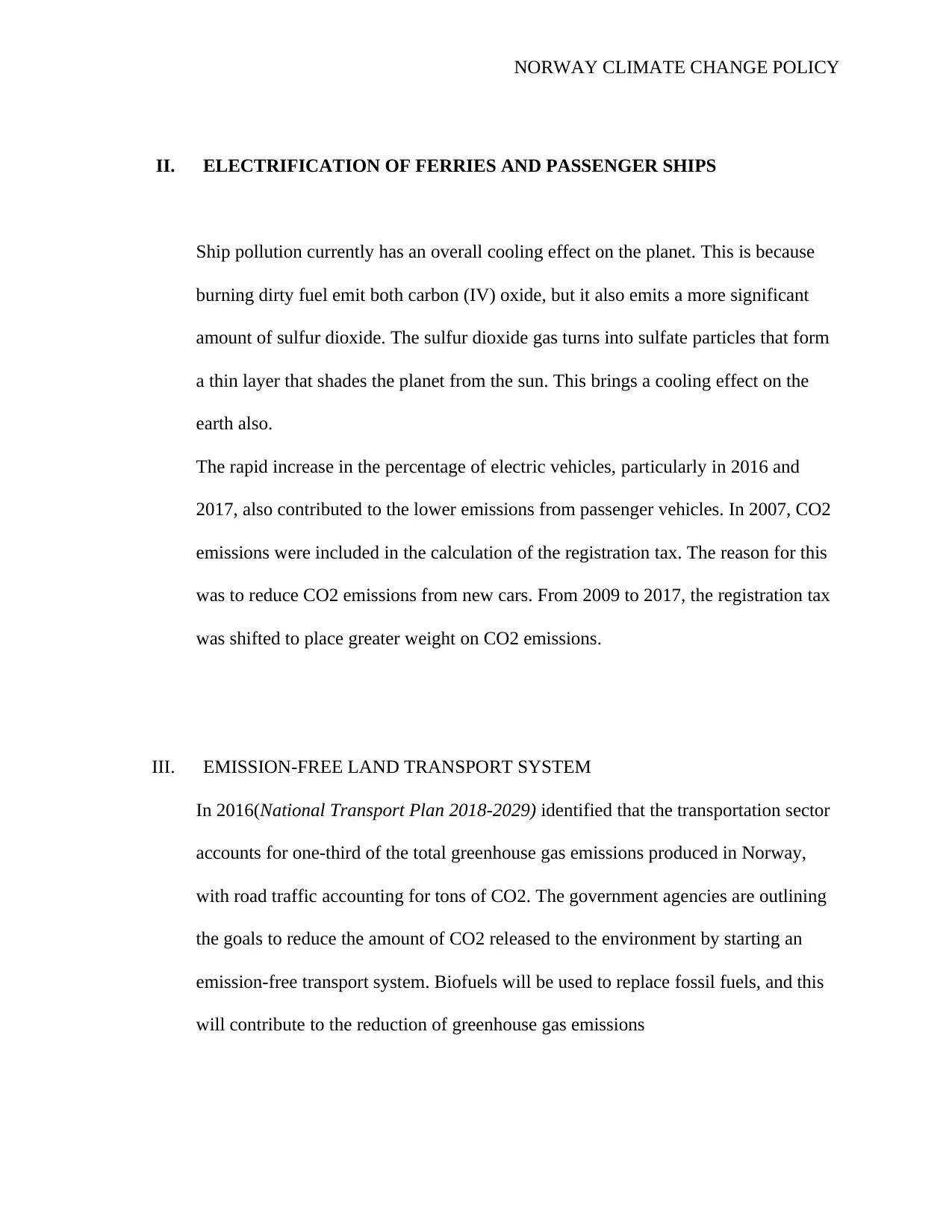
NORWAY CLIMATE CHANGE POLICY
II. ELECTRIFICATION OF FERRIES AND PASSENGER SHIPS
Ship pollution currently has an overall cooling effect on the planet. This is because
burning dirty fuel emit both carbon (IV) oxide, but it also emits a more significant
amount of sulfur dioxide. The sulfur dioxide gas turns into sulfate particles that form
a thin layer that shades the planet from the sun. This brings a cooling effect on the
earth also.
The rapid increase in the percentage of electric vehicles, particularly in 2016 and
2017, also contributed to the lower emissions from passenger vehicles. In 2007, CO2
emissions were included in the calculation of the registration tax. The reason for this
was to reduce CO2 emissions from new cars. From 2009 to 2017, the registration tax
was shifted to place greater weight on CO2 emissions.
III. EMISSION-FREE LAND TRANSPORT SYSTEM
In 2016(National Transport Plan 2018-2029) identified that the transportation sector
accounts for one-third of the total greenhouse gas emissions produced in Norway,
with road traffic accounting for tons of CO2. The government agencies are outlining
the goals to reduce the amount of CO2 released to the environment by starting an
emission-free transport system. Biofuels will be used to replace fossil fuels, and this
will contribute to the reduction of greenhouse gas emissions
II. ELECTRIFICATION OF FERRIES AND PASSENGER SHIPS
Ship pollution currently has an overall cooling effect on the planet. This is because
burning dirty fuel emit both carbon (IV) oxide, but it also emits a more significant
amount of sulfur dioxide. The sulfur dioxide gas turns into sulfate particles that form
a thin layer that shades the planet from the sun. This brings a cooling effect on the
earth also.
The rapid increase in the percentage of electric vehicles, particularly in 2016 and
2017, also contributed to the lower emissions from passenger vehicles. In 2007, CO2
emissions were included in the calculation of the registration tax. The reason for this
was to reduce CO2 emissions from new cars. From 2009 to 2017, the registration tax
was shifted to place greater weight on CO2 emissions.
III. EMISSION-FREE LAND TRANSPORT SYSTEM
In 2016(National Transport Plan 2018-2029) identified that the transportation sector
accounts for one-third of the total greenhouse gas emissions produced in Norway,
with road traffic accounting for tons of CO2. The government agencies are outlining
the goals to reduce the amount of CO2 released to the environment by starting an
emission-free transport system. Biofuels will be used to replace fossil fuels, and this
will contribute to the reduction of greenhouse gas emissions
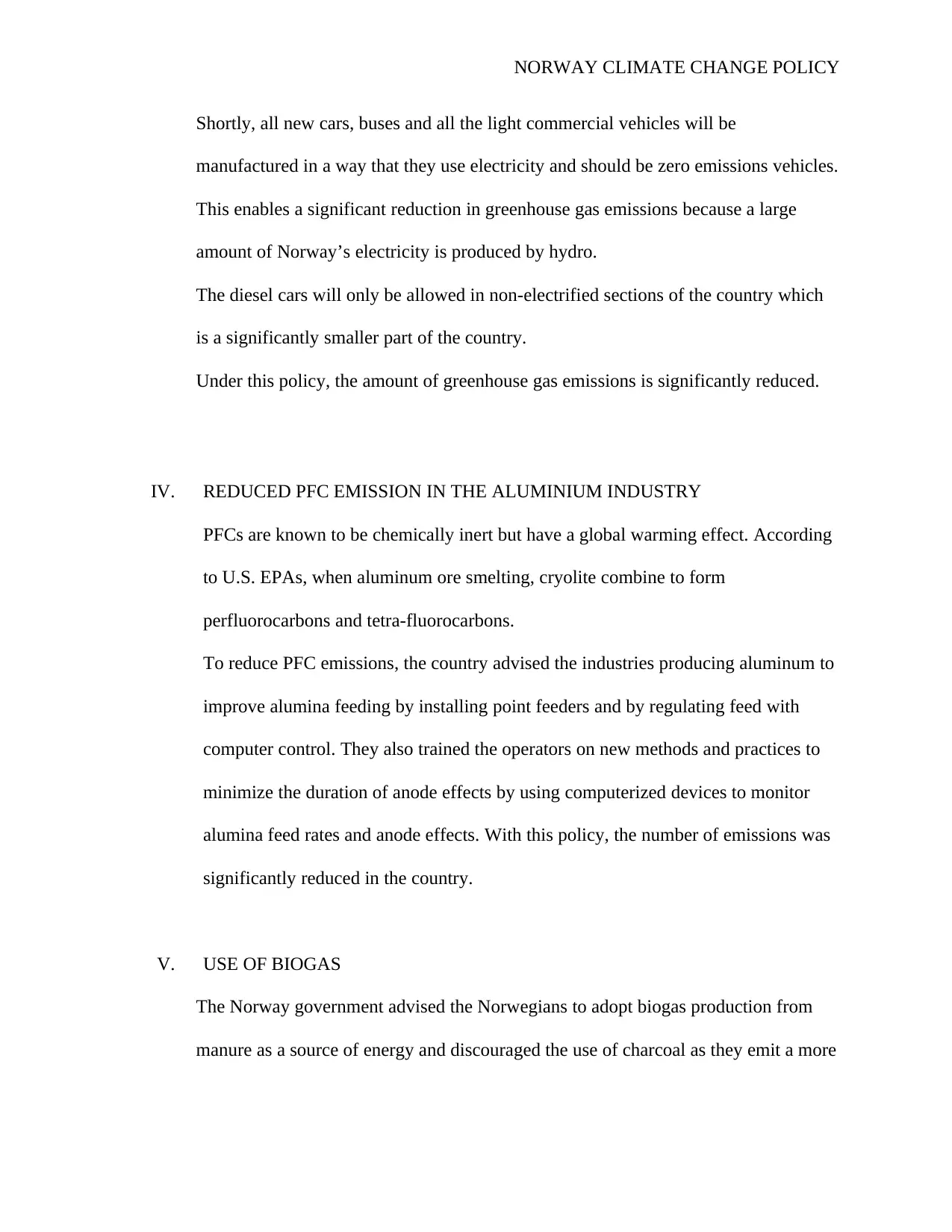
NORWAY CLIMATE CHANGE POLICY
Shortly, all new cars, buses and all the light commercial vehicles will be
manufactured in a way that they use electricity and should be zero emissions vehicles.
This enables a significant reduction in greenhouse gas emissions because a large
amount of Norway’s electricity is produced by hydro.
The diesel cars will only be allowed in non-electrified sections of the country which
is a significantly smaller part of the country.
Under this policy, the amount of greenhouse gas emissions is significantly reduced.
IV. REDUCED PFC EMISSION IN THE ALUMINIUM INDUSTRY
PFCs are known to be chemically inert but have a global warming effect. According
to U.S. EPAs, when aluminum ore smelting, cryolite combine to form
perfluorocarbons and tetra-fluorocarbons.
To reduce PFC emissions, the country advised the industries producing aluminum to
improve alumina feeding by installing point feeders and by regulating feed with
computer control. They also trained the operators on new methods and practices to
minimize the duration of anode effects by using computerized devices to monitor
alumina feed rates and anode effects. With this policy, the number of emissions was
significantly reduced in the country.
V. USE OF BIOGAS
The Norway government advised the Norwegians to adopt biogas production from
manure as a source of energy and discouraged the use of charcoal as they emit a more
Shortly, all new cars, buses and all the light commercial vehicles will be
manufactured in a way that they use electricity and should be zero emissions vehicles.
This enables a significant reduction in greenhouse gas emissions because a large
amount of Norway’s electricity is produced by hydro.
The diesel cars will only be allowed in non-electrified sections of the country which
is a significantly smaller part of the country.
Under this policy, the amount of greenhouse gas emissions is significantly reduced.
IV. REDUCED PFC EMISSION IN THE ALUMINIUM INDUSTRY
PFCs are known to be chemically inert but have a global warming effect. According
to U.S. EPAs, when aluminum ore smelting, cryolite combine to form
perfluorocarbons and tetra-fluorocarbons.
To reduce PFC emissions, the country advised the industries producing aluminum to
improve alumina feeding by installing point feeders and by regulating feed with
computer control. They also trained the operators on new methods and practices to
minimize the duration of anode effects by using computerized devices to monitor
alumina feed rates and anode effects. With this policy, the number of emissions was
significantly reduced in the country.
V. USE OF BIOGAS
The Norway government advised the Norwegians to adopt biogas production from
manure as a source of energy and discouraged the use of charcoal as they emit a more
⊘ This is a preview!⊘
Do you want full access?
Subscribe today to unlock all pages.

Trusted by 1+ million students worldwide
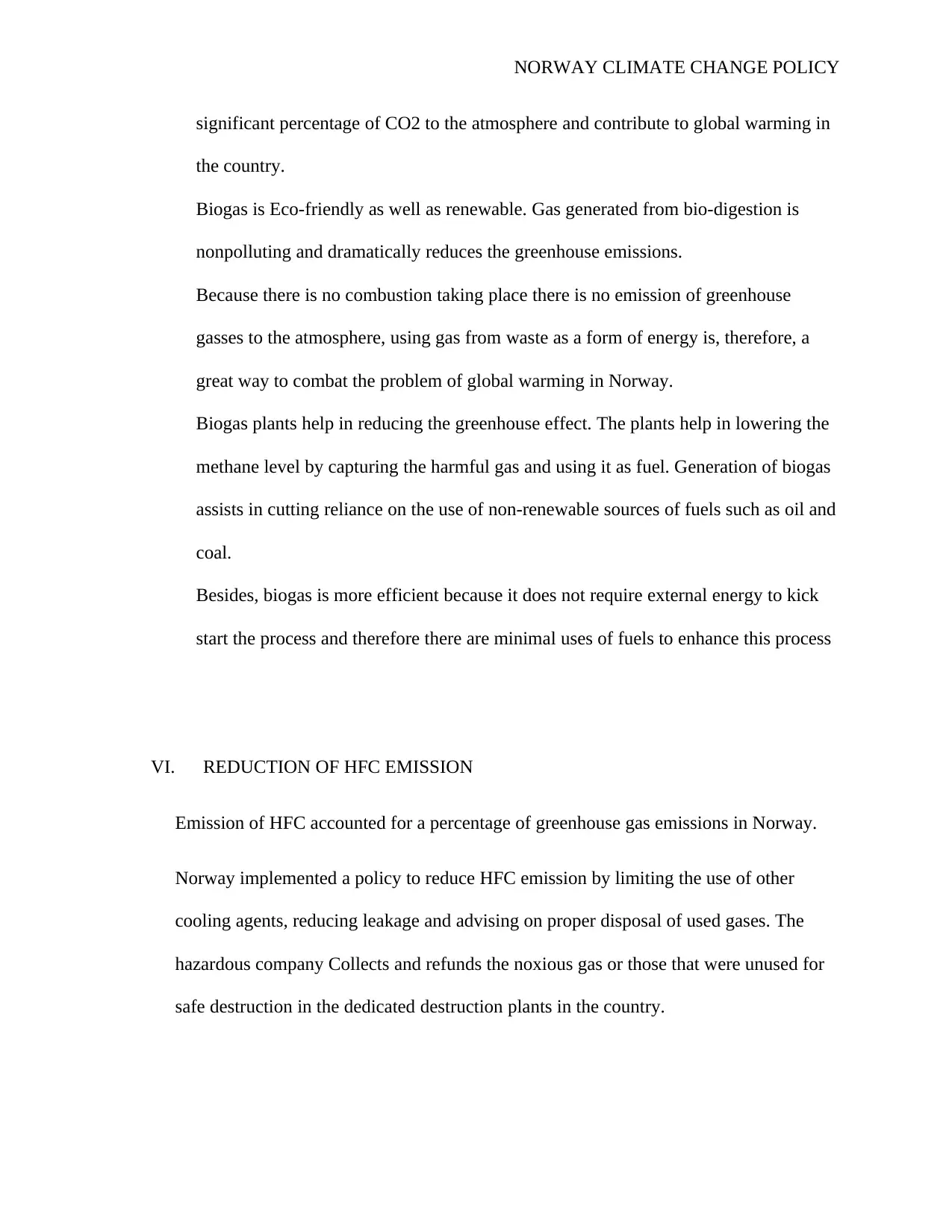
NORWAY CLIMATE CHANGE POLICY
significant percentage of CO2 to the atmosphere and contribute to global warming in
the country.
Biogas is Eco-friendly as well as renewable. Gas generated from bio-digestion is
nonpolluting and dramatically reduces the greenhouse emissions.
Because there is no combustion taking place there is no emission of greenhouse
gasses to the atmosphere, using gas from waste as a form of energy is, therefore, a
great way to combat the problem of global warming in Norway.
Biogas plants help in reducing the greenhouse effect. The plants help in lowering the
methane level by capturing the harmful gas and using it as fuel. Generation of biogas
assists in cutting reliance on the use of non-renewable sources of fuels such as oil and
coal.
Besides, biogas is more efficient because it does not require external energy to kick
start the process and therefore there are minimal uses of fuels to enhance this process
VI. REDUCTION OF HFC EMISSION
Emission of HFC accounted for a percentage of greenhouse gas emissions in Norway.
Norway implemented a policy to reduce HFC emission by limiting the use of other
cooling agents, reducing leakage and advising on proper disposal of used gases. The
hazardous company Collects and refunds the noxious gas or those that were unused for
safe destruction in the dedicated destruction plants in the country.
significant percentage of CO2 to the atmosphere and contribute to global warming in
the country.
Biogas is Eco-friendly as well as renewable. Gas generated from bio-digestion is
nonpolluting and dramatically reduces the greenhouse emissions.
Because there is no combustion taking place there is no emission of greenhouse
gasses to the atmosphere, using gas from waste as a form of energy is, therefore, a
great way to combat the problem of global warming in Norway.
Biogas plants help in reducing the greenhouse effect. The plants help in lowering the
methane level by capturing the harmful gas and using it as fuel. Generation of biogas
assists in cutting reliance on the use of non-renewable sources of fuels such as oil and
coal.
Besides, biogas is more efficient because it does not require external energy to kick
start the process and therefore there are minimal uses of fuels to enhance this process
VI. REDUCTION OF HFC EMISSION
Emission of HFC accounted for a percentage of greenhouse gas emissions in Norway.
Norway implemented a policy to reduce HFC emission by limiting the use of other
cooling agents, reducing leakage and advising on proper disposal of used gases. The
hazardous company Collects and refunds the noxious gas or those that were unused for
safe destruction in the dedicated destruction plants in the country.
Paraphrase This Document
Need a fresh take? Get an instant paraphrase of this document with our AI Paraphraser
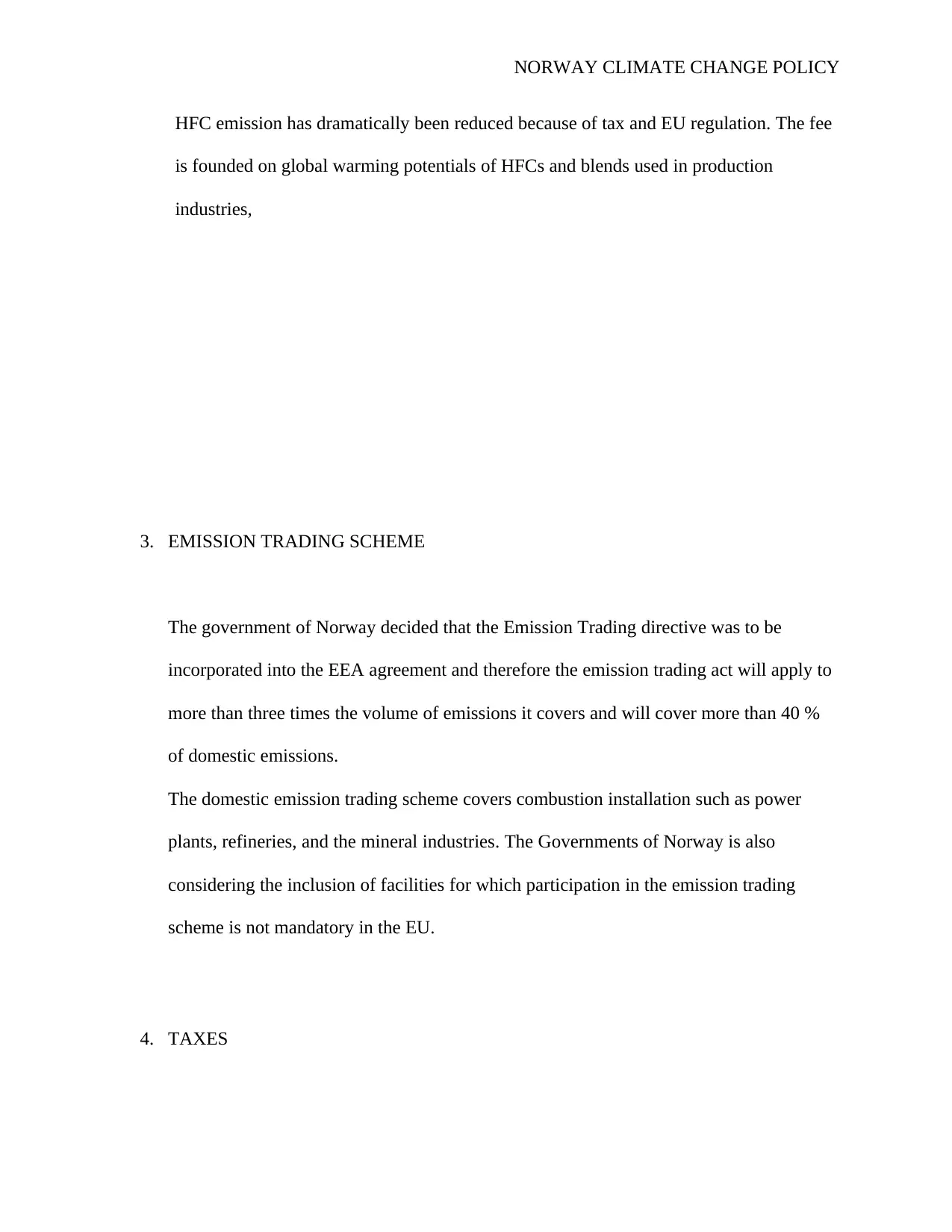
NORWAY CLIMATE CHANGE POLICY
HFC emission has dramatically been reduced because of tax and EU regulation. The fee
is founded on global warming potentials of HFCs and blends used in production
industries,
3. EMISSION TRADING SCHEME
The government of Norway decided that the Emission Trading directive was to be
incorporated into the EEA agreement and therefore the emission trading act will apply to
more than three times the volume of emissions it covers and will cover more than 40 %
of domestic emissions.
The domestic emission trading scheme covers combustion installation such as power
plants, refineries, and the mineral industries. The Governments of Norway is also
considering the inclusion of facilities for which participation in the emission trading
scheme is not mandatory in the EU.
4. TAXES
HFC emission has dramatically been reduced because of tax and EU regulation. The fee
is founded on global warming potentials of HFCs and blends used in production
industries,
3. EMISSION TRADING SCHEME
The government of Norway decided that the Emission Trading directive was to be
incorporated into the EEA agreement and therefore the emission trading act will apply to
more than three times the volume of emissions it covers and will cover more than 40 %
of domestic emissions.
The domestic emission trading scheme covers combustion installation such as power
plants, refineries, and the mineral industries. The Governments of Norway is also
considering the inclusion of facilities for which participation in the emission trading
scheme is not mandatory in the EU.
4. TAXES
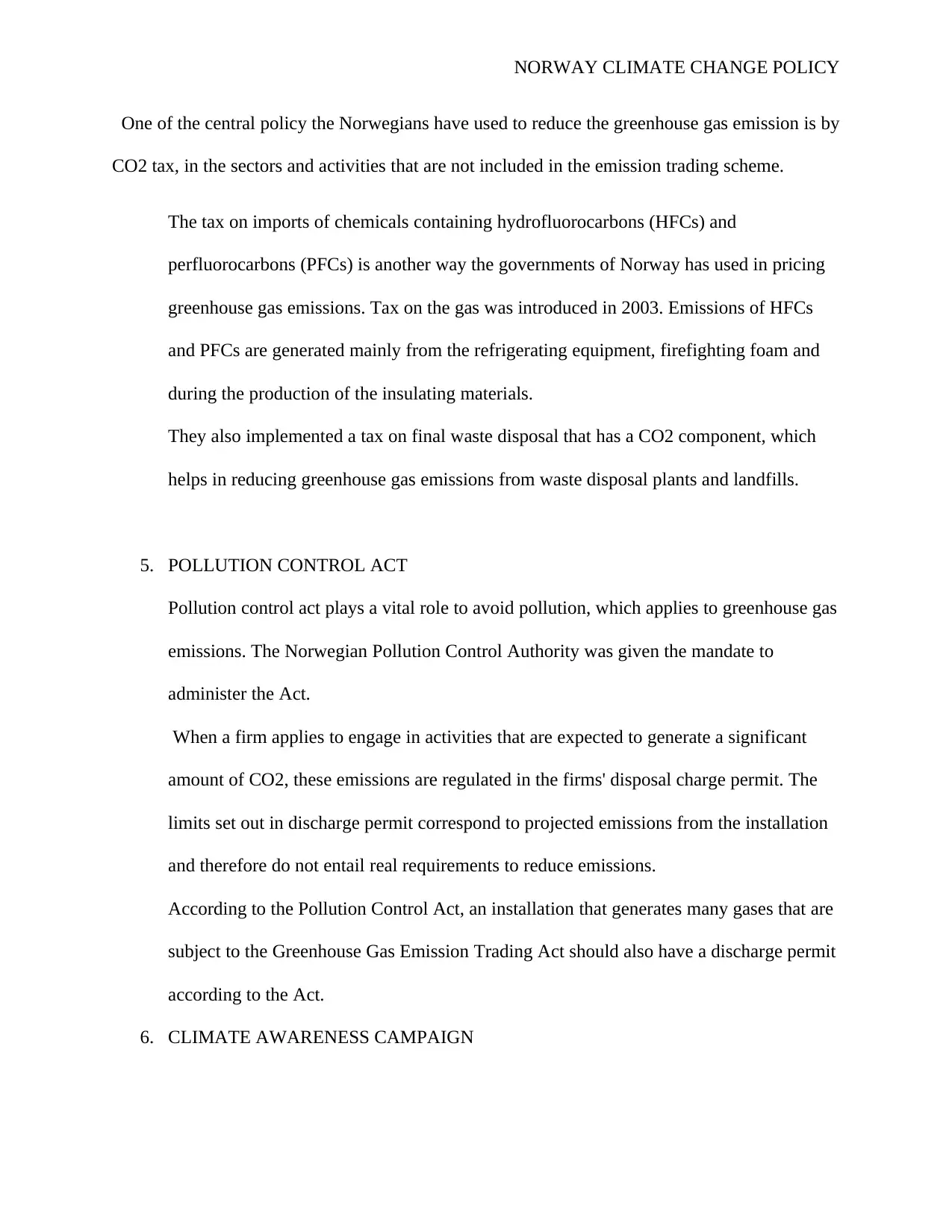
NORWAY CLIMATE CHANGE POLICY
One of the central policy the Norwegians have used to reduce the greenhouse gas emission is by
CO2 tax, in the sectors and activities that are not included in the emission trading scheme.
The tax on imports of chemicals containing hydrofluorocarbons (HFCs) and
perfluorocarbons (PFCs) is another way the governments of Norway has used in pricing
greenhouse gas emissions. Tax on the gas was introduced in 2003. Emissions of HFCs
and PFCs are generated mainly from the refrigerating equipment, firefighting foam and
during the production of the insulating materials.
They also implemented a tax on final waste disposal that has a CO2 component, which
helps in reducing greenhouse gas emissions from waste disposal plants and landfills.
5. POLLUTION CONTROL ACT
Pollution control act plays a vital role to avoid pollution, which applies to greenhouse gas
emissions. The Norwegian Pollution Control Authority was given the mandate to
administer the Act.
When a firm applies to engage in activities that are expected to generate a significant
amount of CO2, these emissions are regulated in the firms' disposal charge permit. The
limits set out in discharge permit correspond to projected emissions from the installation
and therefore do not entail real requirements to reduce emissions.
According to the Pollution Control Act, an installation that generates many gases that are
subject to the Greenhouse Gas Emission Trading Act should also have a discharge permit
according to the Act.
6. CLIMATE AWARENESS CAMPAIGN
One of the central policy the Norwegians have used to reduce the greenhouse gas emission is by
CO2 tax, in the sectors and activities that are not included in the emission trading scheme.
The tax on imports of chemicals containing hydrofluorocarbons (HFCs) and
perfluorocarbons (PFCs) is another way the governments of Norway has used in pricing
greenhouse gas emissions. Tax on the gas was introduced in 2003. Emissions of HFCs
and PFCs are generated mainly from the refrigerating equipment, firefighting foam and
during the production of the insulating materials.
They also implemented a tax on final waste disposal that has a CO2 component, which
helps in reducing greenhouse gas emissions from waste disposal plants and landfills.
5. POLLUTION CONTROL ACT
Pollution control act plays a vital role to avoid pollution, which applies to greenhouse gas
emissions. The Norwegian Pollution Control Authority was given the mandate to
administer the Act.
When a firm applies to engage in activities that are expected to generate a significant
amount of CO2, these emissions are regulated in the firms' disposal charge permit. The
limits set out in discharge permit correspond to projected emissions from the installation
and therefore do not entail real requirements to reduce emissions.
According to the Pollution Control Act, an installation that generates many gases that are
subject to the Greenhouse Gas Emission Trading Act should also have a discharge permit
according to the Act.
6. CLIMATE AWARENESS CAMPAIGN
⊘ This is a preview!⊘
Do you want full access?
Subscribe today to unlock all pages.

Trusted by 1+ million students worldwide
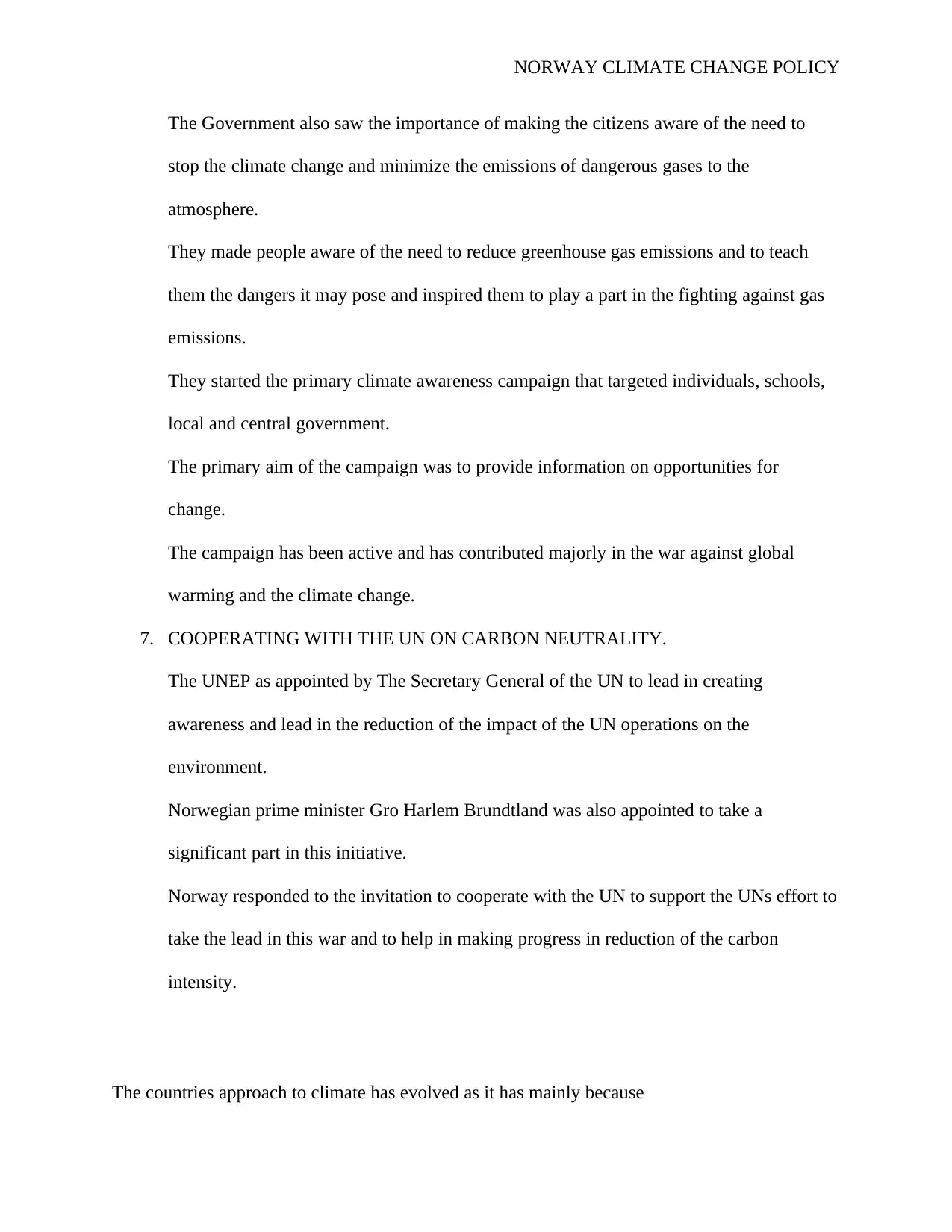
NORWAY CLIMATE CHANGE POLICY
The Government also saw the importance of making the citizens aware of the need to
stop the climate change and minimize the emissions of dangerous gases to the
atmosphere.
They made people aware of the need to reduce greenhouse gas emissions and to teach
them the dangers it may pose and inspired them to play a part in the fighting against gas
emissions.
They started the primary climate awareness campaign that targeted individuals, schools,
local and central government.
The primary aim of the campaign was to provide information on opportunities for
change.
The campaign has been active and has contributed majorly in the war against global
warming and the climate change.
7. COOPERATING WITH THE UN ON CARBON NEUTRALITY.
The UNEP as appointed by The Secretary General of the UN to lead in creating
awareness and lead in the reduction of the impact of the UN operations on the
environment.
Norwegian prime minister Gro Harlem Brundtland was also appointed to take a
significant part in this initiative.
Norway responded to the invitation to cooperate with the UN to support the UNs effort to
take the lead in this war and to help in making progress in reduction of the carbon
intensity.
The countries approach to climate has evolved as it has mainly because
The Government also saw the importance of making the citizens aware of the need to
stop the climate change and minimize the emissions of dangerous gases to the
atmosphere.
They made people aware of the need to reduce greenhouse gas emissions and to teach
them the dangers it may pose and inspired them to play a part in the fighting against gas
emissions.
They started the primary climate awareness campaign that targeted individuals, schools,
local and central government.
The primary aim of the campaign was to provide information on opportunities for
change.
The campaign has been active and has contributed majorly in the war against global
warming and the climate change.
7. COOPERATING WITH THE UN ON CARBON NEUTRALITY.
The UNEP as appointed by The Secretary General of the UN to lead in creating
awareness and lead in the reduction of the impact of the UN operations on the
environment.
Norwegian prime minister Gro Harlem Brundtland was also appointed to take a
significant part in this initiative.
Norway responded to the invitation to cooperate with the UN to support the UNs effort to
take the lead in this war and to help in making progress in reduction of the carbon
intensity.
The countries approach to climate has evolved as it has mainly because
Paraphrase This Document
Need a fresh take? Get an instant paraphrase of this document with our AI Paraphraser
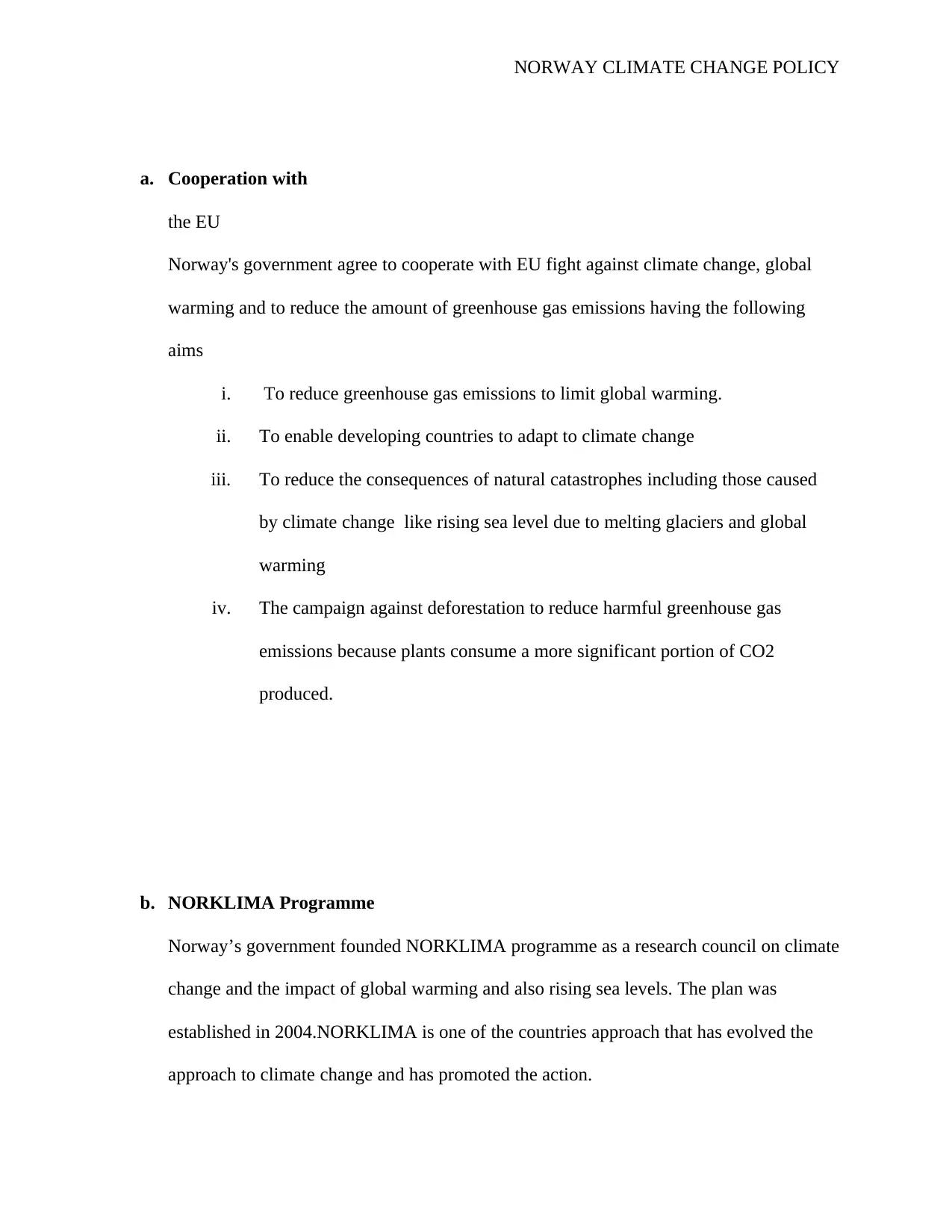
NORWAY CLIMATE CHANGE POLICY
a. Cooperation with
the EU
Norway's government agree to cooperate with EU fight against climate change, global
warming and to reduce the amount of greenhouse gas emissions having the following
aims
i. To reduce greenhouse gas emissions to limit global warming.
ii. To enable developing countries to adapt to climate change
iii. To reduce the consequences of natural catastrophes including those caused
by climate change like rising sea level due to melting glaciers and global
warming
iv. The campaign against deforestation to reduce harmful greenhouse gas
emissions because plants consume a more significant portion of CO2
produced.
b. NORKLIMA Programme
Norway’s government founded NORKLIMA programme as a research council on climate
change and the impact of global warming and also rising sea levels. The plan was
established in 2004.NORKLIMA is one of the countries approach that has evolved the
approach to climate change and has promoted the action.
a. Cooperation with
the EU
Norway's government agree to cooperate with EU fight against climate change, global
warming and to reduce the amount of greenhouse gas emissions having the following
aims
i. To reduce greenhouse gas emissions to limit global warming.
ii. To enable developing countries to adapt to climate change
iii. To reduce the consequences of natural catastrophes including those caused
by climate change like rising sea level due to melting glaciers and global
warming
iv. The campaign against deforestation to reduce harmful greenhouse gas
emissions because plants consume a more significant portion of CO2
produced.
b. NORKLIMA Programme
Norway’s government founded NORKLIMA programme as a research council on climate
change and the impact of global warming and also rising sea levels. The plan was
established in 2004.NORKLIMA is one of the countries approach that has evolved the
approach to climate change and has promoted the action.
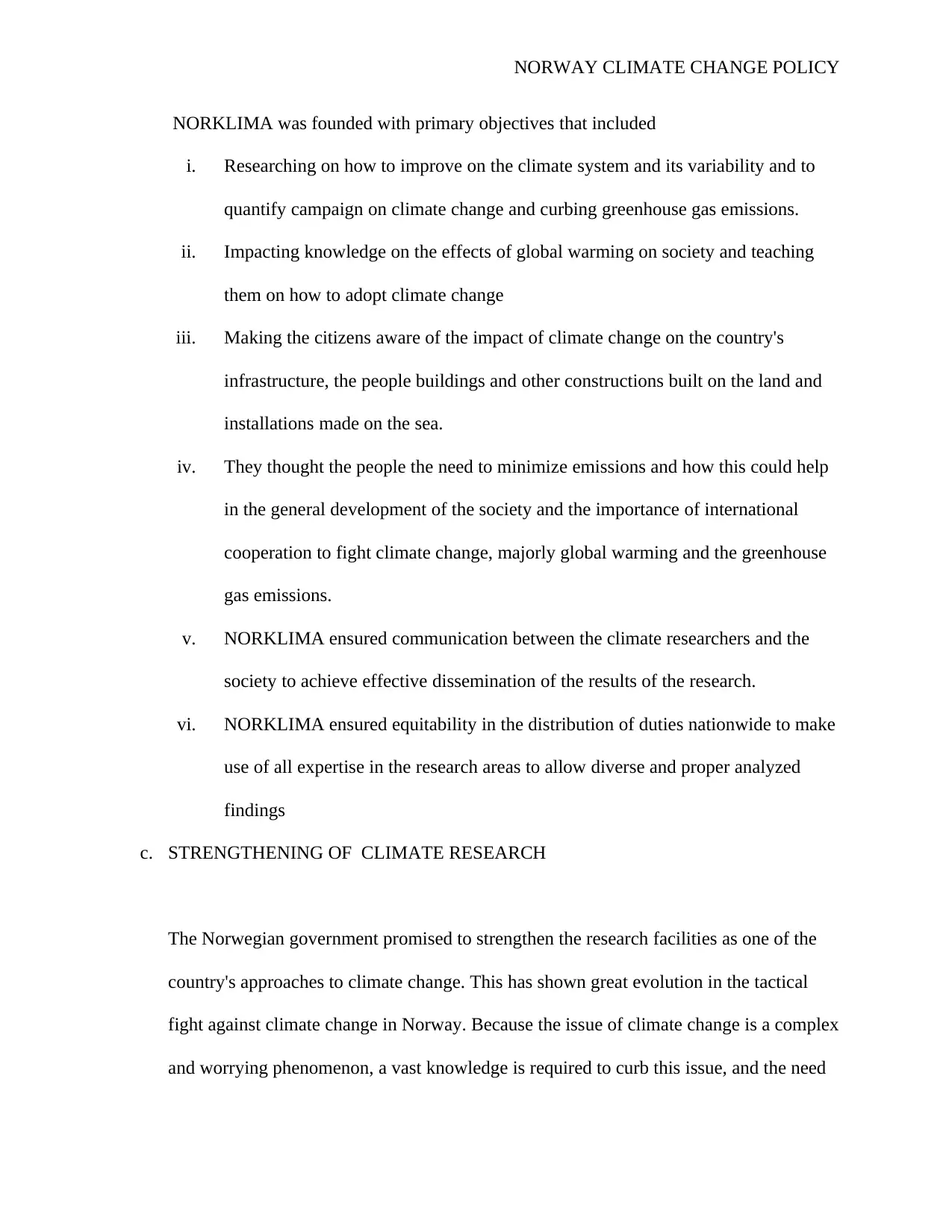
NORWAY CLIMATE CHANGE POLICY
NORKLIMA was founded with primary objectives that included
i. Researching on how to improve on the climate system and its variability and to
quantify campaign on climate change and curbing greenhouse gas emissions.
ii. Impacting knowledge on the effects of global warming on society and teaching
them on how to adopt climate change
iii. Making the citizens aware of the impact of climate change on the country's
infrastructure, the people buildings and other constructions built on the land and
installations made on the sea.
iv. They thought the people the need to minimize emissions and how this could help
in the general development of the society and the importance of international
cooperation to fight climate change, majorly global warming and the greenhouse
gas emissions.
v. NORKLIMA ensured communication between the climate researchers and the
society to achieve effective dissemination of the results of the research.
vi. NORKLIMA ensured equitability in the distribution of duties nationwide to make
use of all expertise in the research areas to allow diverse and proper analyzed
findings
c. STRENGTHENING OF CLIMATE RESEARCH
The Norwegian government promised to strengthen the research facilities as one of the
country's approaches to climate change. This has shown great evolution in the tactical
fight against climate change in Norway. Because the issue of climate change is a complex
and worrying phenomenon, a vast knowledge is required to curb this issue, and the need
NORKLIMA was founded with primary objectives that included
i. Researching on how to improve on the climate system and its variability and to
quantify campaign on climate change and curbing greenhouse gas emissions.
ii. Impacting knowledge on the effects of global warming on society and teaching
them on how to adopt climate change
iii. Making the citizens aware of the impact of climate change on the country's
infrastructure, the people buildings and other constructions built on the land and
installations made on the sea.
iv. They thought the people the need to minimize emissions and how this could help
in the general development of the society and the importance of international
cooperation to fight climate change, majorly global warming and the greenhouse
gas emissions.
v. NORKLIMA ensured communication between the climate researchers and the
society to achieve effective dissemination of the results of the research.
vi. NORKLIMA ensured equitability in the distribution of duties nationwide to make
use of all expertise in the research areas to allow diverse and proper analyzed
findings
c. STRENGTHENING OF CLIMATE RESEARCH
The Norwegian government promised to strengthen the research facilities as one of the
country's approaches to climate change. This has shown great evolution in the tactical
fight against climate change in Norway. Because the issue of climate change is a complex
and worrying phenomenon, a vast knowledge is required to curb this issue, and the need
⊘ This is a preview!⊘
Do you want full access?
Subscribe today to unlock all pages.

Trusted by 1+ million students worldwide
1 out of 18
Related Documents
Your All-in-One AI-Powered Toolkit for Academic Success.
+13062052269
info@desklib.com
Available 24*7 on WhatsApp / Email
![[object Object]](/_next/static/media/star-bottom.7253800d.svg)
Unlock your academic potential
Copyright © 2020–2025 A2Z Services. All Rights Reserved. Developed and managed by ZUCOL.



